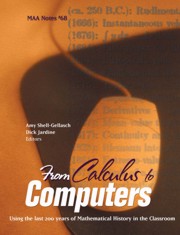Book contents
- Frontmatter
- Preface
- Contents
- Introduction
- I Algebra, Number Theory, Calculus, and Dynamical Systems
- 1 Arthur Cayley and the First Paper on Group Theory
- 2 Putting the Differential Back Into Differential Calculus
- 3 Using Galois' Ideas in the Teaching of Abstract Algebra
- 4 Teaching Elliptic Curves Using Original Sources
- 5 Using the Historical Development of Predator-Prey Models to Teach Mathematical Modeling
- II Geometry
- III Discrete Mathematics, Computer Science, Numerical Methods, Logic, and Statistics
- IV History of Mathematics and Pedagogy
- About the Authors
1 - Arthur Cayley and the First Paper on Group Theory
from I - Algebra, Number Theory, Calculus, and Dynamical Systems
- Frontmatter
- Preface
- Contents
- Introduction
- I Algebra, Number Theory, Calculus, and Dynamical Systems
- 1 Arthur Cayley and the First Paper on Group Theory
- 2 Putting the Differential Back Into Differential Calculus
- 3 Using Galois' Ideas in the Teaching of Abstract Algebra
- 4 Teaching Elliptic Curves Using Original Sources
- 5 Using the Historical Development of Predator-Prey Models to Teach Mathematical Modeling
- II Geometry
- III Discrete Mathematics, Computer Science, Numerical Methods, Logic, and Statistics
- IV History of Mathematics and Pedagogy
- About the Authors
Summary
Introduction
Arthur Cayley's 1854 paper On the theory of groups, as depending on the symbolic equation θn = 1 inaugurated the abstract idea of a group [2]. I have used this very understandable paper several times for reading, discussion, and homework in teaching introductory abstract algebra, where students are first introduced to group theory. Many facets of this short paper provide wonderful pedagogical benefits, not least of which is tremendous motivation for the modern theory. More information on teaching with original historical sources is available at our web resource [8], which includes information on the efficacy of teaching with original sources [3, 4, 5, 9, 10], about courses based entirely on original sources [6, 7], and which provides access to books and other resources for teaching with original sources.
Cayley introduces groups as a unifying framework for several critical examples current in the early nineteenth century. These include “substitutions” (permutations, with reference to Galois on solutions of equations), “quaternion imaginaries,” compositions arising in the theory of elliptic functions, and transposition and inversion of matrices. These phenomena are either familiar to or easily understandable for our students. Cayley observes that they all have common features, which he abstracts in a first attempt at defining a group axiomatically. He proceeds to develop initial steps of a theory, including stating and using what Lagrange's theorem tells us on orders of elements, which classifies groups of prime order.
- Type
- Chapter
- Information
- From Calculus to ComputersUsing the Last 200 Years of Mathematics History in the Classroom, pp. 3 - 8Publisher: Mathematical Association of AmericaPrint publication year: 2005
- 3
- Cited by

